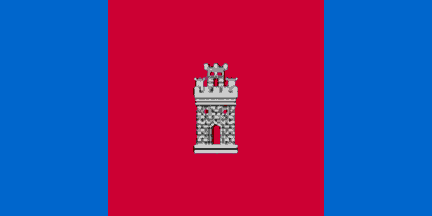
image by Jens Pattke, 29 October 2002

Last modified: 2015-01-17 by zoltán horváth
Keywords: ecuador | pichincha | quito | amaguana | san francisco de quito |
Links: FOTW homepage |
search |
disclaimer and copyright |
write us |
mirrors

image by Jens Pattke, 29 October 2002
See also:
The flag above is based on the province
official site.
Falko Schmidt, 29 October 2002
The flag is presented on the municipal
website as follows:
"Decree No. 1634
The flag of the town was officialized on 17 May 1944 by the
Municipal Council of Quito. It is made of a horizontal rectangle
divided into three parallel stripes: the central part is red and
the two lateral parts are blue. In the middle is shows a castle
as a symbol of strength, nobleness and loyalty of the town. The
finial of the staff is decorated with the golden ribbon of St.
Francis."
There is more information on the website
of the Province of Pichincha. The text is exactly as above,
but there is an image of the flag showing the central red stripe
twice wider than the blue ones.
There are several reports of the flag with the municipal coat of
arms instead of the castle. The most recent sighting is a
photograph, published in "La
Hora" on 21 October 2008, of the last meeting of the
Supreme Court of Justice, to be replaced soon by the new National
Court of Justice.
The coat of arms is described on themunicipal
website as follows:
"Decree No. 3111
The coat of arms of the Town of San Francisco de Quito was
granted by Emperor Charles V, King of Germany and Spain, by the
Royal Letter signed on 14 March 1541 in the palace of Talavera,
Spain. This Letter, following a first Letter granting the title
of Town to an Francisco de Quito, granted to the town a coat of
arms which has been used until today.
The Royal Letter grants to Quiot "all the pre-eminences,
prerogatives and immunities that it can and shall have as a
town" and commission the whole Royal Court to respect and
let respect this rank for Quito. The document prescribed to the
new Town of Quito a coat of arms and a blazon, which have been
kept until now and make of the coat of arms of Quito the oldest
of all the coats of arms granted to towns and provinces of
Ecuador, highlighting the importance of the town in the history
of our country.
The Emperor ordered the coat of arms of Quito to be "a
castle argent surrounded by two mountains or rocks, with a green
cave on the base of each of them, on the top of the castle a
cross or with a base vert hold in their claws by two eagles sable
fimbriated or, one dexter and the other sinister, [...], the
whole on a field gules; an orle made of the St. Francis ribbon or
on a field azure".
The coats of arms was immediatly used in all the documents of the
town's administration. According to a report published in
1914 by Pedro Pablo Traversari, once a Municipal
Councillor in Quito, and whose original illustrated manuscript is
thoroughly kept in the reserve of the Municipal Historic Museum,
the oldest reproduction of the coat of arms of Quito that we can
still observe is the coat of arms encarved in a stone located on
the facade of the St. Augustine convent. According to Traversari,
this coat of arms is dated 1573.
For the commemoration of the 460th anniversary of the Royal
Letter, Paco Moncayo, Mayor of the Metropolitan Disctrict of
Quito, unvealed last March a polychromous coat of arms of Quito,
encarved in cedar wood by the artist Whitman Villalba. Villalba's
coat of arms is a model based on Traversari's detailed drawing
and reproducing the central element of the coat of arms of Quito,
the crenelled tower, crowned by the cross, in a beautiful
silversmith's piece kept by the municipality for centuries [...]
This work is part of the Hall of the Coat of Arms of Quito,
located in the Municipal Palace and placed under the custody of
the Metropolitan District of Quito."
The website
of the Province of Pichincha gives fragments of this text.
Ivan Sache, 26 October 2008
![[Flag of Quito]](../images/e/ec-p-q.gif)
image by T.F. Mills, 11 December 1997
Quito's flag is a blue-red-blue tricolour, and about half of
them showed a coat of arms.
I made the "Variant (?)" from a small flag which I
purchased in Quito shortly before submitting them. I saw
many more like them on buildings and none like the 1944 model --
so I think your assumptions are fairly sound. I know very
little about the vexillographic culture of Ecuador, but in my
experience much of the world does not have "sealed
patterns". It is therefore possible that the
difference is not an official evolution.
T.F. Mills, 11 December 1997 and 13 December 2001
![[Coat-of-Arms of Quito]](../images/e/ec-p-qca.jpg)
image from website
of the Province of Pichincha